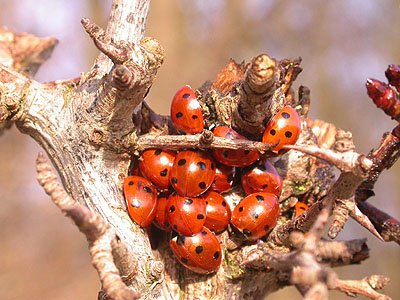| ........... |
| Location |
|
Species |
| Young Pines and
Gorse often near the end of the previous years
growth |
|
7-spot Ladybird,
11-spot Ladybird and Adonis
Ladybird. Occasionally
Cream-streaked Ladybird, Pine
Ladybird, 2-spot Ladybird and
Kidney-spot Ladybird |
| On mature Pines,
possibly near top of previous year's growth |
|
Striped Ladybird.
The over-wintering sites of this species are
still not known to science. One was found after
severe winds on the foliage of a fallen Scots
Pine in January 2007. (underneath the bark of
mature Pines seems the most likely hibernation
site) A second was found at the end of previous
year's growth, at a height of two metres on Budby
South Forest in January 2010. |
| On dead vegetation
such as Thistle heads, Burdock, Willowherb and
Bramble |
|
7-spot Ladybird,
Adonis Ladybird and occasionally
Harlequin Ladybird |
| Within crevices on
tree trunks |
|
Orange Ladybird,
Heather Ladybird, Cream-streaked
Ladybird (underneath flaky bark of
mature Pine) and Pine Ladybird |
| Underneath fallen
logs and the bark of dead trees |
|
Harlequin Ladybird
and 2-spot Ladybird,
occasionally Orange Ladybird and
14-spot Ladybird |
| Within hollow stems and
between old leaves and stems of Bulrush by water |
|
Water Ladybird,
Harlequin Ladybird, Coccidula
rufa and Coccidula
scutellata |
| On evergreen shrubs, usually
within curled or rolled up leaves |
|
14-spot Ladybird and
10-spot Ladybird. We recorded both these
species over-wintering for the first time during
garden maintenance work in late Janury 2011. |
| In leaf litter |
|
16-spot Ladybird, 14-spot Ladybird, 10-spot
Ladybird, 7-spot Ladybird, Harlequin Ladybird and Cream-spot Ladybird |


